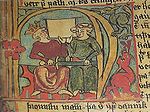- Old Covenant (Iceland)
-
- For the theological use of Old Covenant, see Mosaic Covenant, Covenant (biblical) and Old Testament.
The Old Covenant (Icelandic: Gamli sáttmáli) was the name of the agreement which effected the union of Iceland and Norway. It is also known as Gissurarsáttmáli, named after Gissur Þorvaldsson, the Icelandic chieftain who worked to promote it. The name "Old Covenant", however, is probably due to historical confusion. Gamli sáttmáli is properly the treaty of 1302 mentioned below and the treaty of 1262 is the actual Gissurarsáttmáli.
The agreement was made in 1262-1264 between the major chieftains of Iceland and Haakon IV of Norway, and his son and successor, Magnus the Lawgiver. The signing brought about the union of Iceland with Norway, which subsequently led to Iceland's union with Denmark in 1380, by way of the Kalmar Union.
The years preceding the signing of the accord were marked by civil strife in Iceland (the so-called Age of the Sturlungs), as the Norwegian king tried to exert his influence through the Icelandic family clans, most notably the Sturlungs. Gissur Þorvaldsson, a vassal of the king, worked as his agent in the matter.
According to the provisions in the agreement, the Icelanders were to bear taxation from the Norwegian king, but in exchange they were to receive a code of laws, guaranteed peace and reliable transportation and shipping between Norway and Iceland. Norwegians and Icelanders received equal rights in each others' countries. The laws of the Icelandic Commonwealth were updated and a book of laws named Jónsbók was issued in 1281.
The agreement was renewed in 1302 at the behest of Haakon V of Norway. Iceland's union with Norway (and, after the Treaty of Kiel, with Denmark) lasted until 1944, during World War II, when the Republic of Iceland was founded.
The use of the sagas as accurate historical sources has been questioned by historian Patricia Pires Boulhosa who claims Gamli sáttmáli is a much younger document and was used to negotiate with the Norwegian king for the benefit of Icelanders.[citation needed]
References
- Árni Daníel Júlíusson, Jón Ólafur Ísberg, Helgi Skúli Kjartansson Íslenskur sögu atlas: 1. bindi: Frá öndverðu til 18. aldar Almenna bókafélagið, Reykjavík 1989
- Patricia Pires Boulhosa Icelanders and the Kings of Norway: Medieval Sagas and Legal Texts, The Northern World, Brill Academic 2005
 The Age of the Sturlungs
The Age of the SturlungsFamily clans Goði chieftains Snorri Sturluson | Sighvatur Sturluson | Sturla Sighvatsson | Þórður kakali Sighvatsson | Sturla Þórðarson | Gissur Þorvaldsson | Kolbeinn ungi Arnórsson | Brandur Kolbeinsson | Eyjólfur ofsi ÞorsteinssonBattles and conflicts Politics Haakon IV of Norway | Hallvarður gullskór | Vassalage | Old Covenant | Icelandic Commonwealth | Jarldom | Althingi | GoðorðCategories:- Legal history of Iceland
- Political history of Norway
- History of the Germanic peoples
- Legal history of Norway
- Iceland stubs
- Norwegian history stubs
Wikimedia Foundation. 2010.

